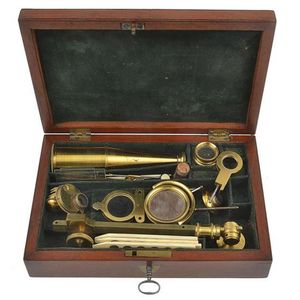19th Century Brass Cary Microscope with Accessories
You must be a subscriber, and be logged in to view price and dealer details.
Subscribe Now to view actual auction price for this item
When you subscribe, you have the option of setting the currency in which to display prices to $Au, $US, $NZ or Stg.
- Mahogany - Mahogany is a dense, close grained red-coloured timber from the West Indies and Central America. It was first imported into Europe in the the early 18th century and its use continued through the 19th century. It was popular for furniture making because of its strength, the wide boards available, the distinctive grain on some boards, termed flame mahogany and the rich warm colour of the timber when it was polished.. The "flame" was produced where a limb grew out from the trunk of the tree, and this timber was usually sliced into veneers for feature panels on doors, backs and cornices.
Some terms used to describe mahogany relate to the country from which it originally came, such as "Cuban" mahogany, "Honduras" mahogany etc. However unless the wood has been tested the names assigned are more a selling feature, rather than a true indication of the timber's origin.
This item has been included into following indexes:
Visually similar items

Griffin of London gold weights in Bakelite case

Orpheus musical cylinder jewellery box, manufactured by Sanko Seiki Mfg. Co. Ltd. Japan, the wooden case is brass corner bound and finished in high gloss varnish, the cylinder movement plays two Beethoven tunes Symphony no 5 Schiksal and Symphony no 9 Chor

A Zeiss R.Winkel Gottingen microscope, boxed and with various components C1915 together with Leitz booklet, slides and accessories, some fittings missing from box

A fine quality George IV period Coromandel wood dressing case with silver fittings, the various silver canisters, silver lidded glass boxes and jars with ornate scroll framed cartouches engraved with the crest of a bull's head. Halstaff & Hannaford Manufac
